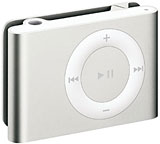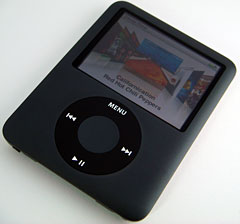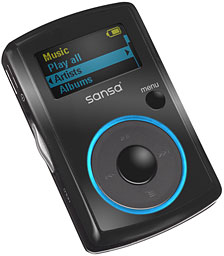 |
| About Alan |
| Tutorials |
| Free files |
| Win9x FAQs |
| E-mail Alan |
| |
| Articles |
| BIV articles |
| Archive |
| Other articles |
| Archive |
| |
 |
|
|
|
SanDisk
Sansa Clip a Low Cost Alternative to iPods for Mac Users
by Alan Zisman (c) 2008 First published in Low End Mac July 1 2008 Zis Mac column I recently had a bit of a quandary - I wanted to send an MP3 player to a music-deprived friend. I wanted it to work with both Windows and Macs. And I wanted it to cost under $100.  The
iPod shuffle (C$55-$75) wasn't going to do the trick; shuffle mode is a
fun way to randomly bring up tunes, like a radio station that only
programs songs that you like. But I wanted my friend to have the option
of shuffle mode when he wanted it - and of being able to play specific
albums, artists, or songs when he wanted that too. And I wanted him to
be able to tell what song was playing. You can't do that on an iPod
shuffle either. The
iPod shuffle (C$55-$75) wasn't going to do the trick; shuffle mode is a
fun way to randomly bring up tunes, like a radio station that only
programs songs that you like. But I wanted my friend to have the option
of shuffle mode when he wanted it - and of being able to play specific
albums, artists, or songs when he wanted that too. And I wanted him to
be able to tell what song was playing. You can't do that on an iPod
shuffle either.The iPod nano (C$159-209) would do everything I wanted except fit in my budget. In fact, unless I was prepared to buy a secondhand iPod, none of Apple's models would fit my needs. MP3 Players for Macs Other MP3 player manufacturers don't exactly spend a lot of time marketing their products to Mac owners - they've pretty much concluded that if you own a Mac and are shopping for a music player, you're probably going to buy an iPod. And if you plug many of these models into your Mac - like Microsoft's Zune or any of Creative's many models - nothing pops up on your desktop; there's no indication that you've got anything attached.  These
models use a connection standard called MTP; they require additional
software installed to allow them to be recognized on Windows systems.
I'm not aware of manufacturers of MTP players who include Mac-able
software. The open source XNJB can be used, however, to allow many (but
not all) of these music players to work, at least to some degree, with
Macs. These
models use a connection standard called MTP; they require additional
software installed to allow them to be recognized on Windows systems.
I'm not aware of manufacturers of MTP players who include Mac-able
software. The open source XNJB can be used, however, to allow many (but
not all) of these music players to work, at least to some degree, with
Macs.Some other models, however, use a connection standard known varyingly as UMS or MSC; these models, when connected, appear to be an external USB drive - on Windows, Linux, and Mac systems. As a result, they can be used without requiring any additional software or drivers on any of those systems - just drag music files to the Music folder, and you're in business. (While many - though not all - iPods can be set to appear as external drives, Apple has hidden the Music and other media folders, making it more difficult, though not impossible, to work with them in this straightforward manner). SanDisk Sansa Clip As a result, at least some models of MP3 players from companies including SanDisk, Archos, and even Sony, can be used with non-Windows computers. I went shopping for a SanDisk Sansa Clip, and found a 4 GB model for about C$80 - a bit more than half the price of a comparably-sized iPod nano. (There are also 1 GB and 2 GB Clip models available). Apparently, as a memory manufacturer, SanDisk is able produce flash memory music players and other flash RAM devices cheaply. SanDisk holds the #2 spot in MP3 players, though its market share is far below Apple's.  The
Clip is a small (2.2" by 1.4" by 0.5") device with a 1" square colour
display and a round 4-position control pad with a select button in the
centre. As well, there's a Home button, a volume switch on the side,
and USB and headphone jacks. A removable belt-clip is also included.
The interface lets you find tunes by album or artist as well as by song
name. The
Clip is a small (2.2" by 1.4" by 0.5") device with a 1" square colour
display and a round 4-position control pad with a select button in the
centre. As well, there's a Home button, a volume switch on the side,
and USB and headphone jacks. A removable belt-clip is also included.
The interface lets you find tunes by album or artist as well as by song
name.Although I had seen a review of the Clip noting that it could connect to Macs, there was no indication on the packaging that it was Mac-compatible; the box listed system requirements as Windows XP2 and Windows Media Player 10. Luckily, I could have brought it back for a refund if it hadn't worked for me. The Clip comes with a short USB cable; when it was connected to my Mac, it promptly appeared as an external drive - the Clip's 1" screen showed that it was connected and charging. Double-clicking the drive icon on my Mac showed folders labeled Music and Audible (for Audible book recordings). It was no sweat to copy album folders from my Mac into the Music folder. The real test, of course, is whether the music works. The Clip's packaging promises support for MP3 and both protected and unprotected Windows Media music files, along with Audible book files. There's no support for Apple's AAC file format, used by default when you rip CDs to iTunes or download copy-protected music from the iTunes Store. Because I routinely set iTunes to rip CDs to MP3, the music files that I copied over to the Clip played without problem, showing artist and album information on its small screen. Unlike the pricier iPod nano, there's no support for photos or video files - though you could use the Clip as an external drive to transport these or other data files. But there are several features that you don't get on any iPod model, at least not without buying third-party add-ons. The Clip has a built-in FM radio tuner with support for up to 40 preset stations. There's a built-in mike and voice recorder. There's even an adjustable five-band equalizer. Sound quality is pretty good, especially for such an inexpensive device. As with Apple's iPods, you may want to ditch the included earbuds for something better - I use Creative's Zen Aurvana in-ear earphones. It's not going to replace my iPod touch, but it's nice to know that however much Mac owners may like Apple's iPod models, there are other Mac-usable MP3 players available. I just wish SanDisk would mention this on their product packaging! Comment (Feb 2011): Brian Keegan writes - "Thanks for your article on using a Sandisk mp3 player with Mac. I found it to use as support after buying a Sandisk player out of desperation. I was in a similar budgetary spot, wanting a low cost way to share music. I bought an iPod Shuffle for my niece for xmas, only to find out that it no longer had system software up-to-date enough to interface with the new iPods. Really irritating. Thanks Apple. Since I'd used Sandisk memory sticks with success, I was hoping Sandisk would be the brand that would interface with my Mac, and sure enough it did. Unlike you, I've always ripped using the high-end Mac file format. But I knew this was going to be an issue, so I investigated, and found that iTunes allows you to convert file formats. So no new software needed. I can make mp3 copies of AAC files. Hopefully I'll be able to batch convert files to mp3 copies. I have only done one so far as a test. The "within iTunes"ability to convert files might be useful information to add to your article. Also wanted to point out to you that as of now, the story on costs is even better for sandisk players than your 2008 links suggest. A 4MB Sansa Clip is only $37 dollars." Note - iTunes includes the option to change its default music format (used for ripping CDs, etc) to MP3, and includes an 'Advanced' menu offering to create an MP3 copy of an existing music file. By selecting multiple songs at a time, this can be used to 'batch' convert bunches of files at one go - though then getting those files where you want them can be a bit of a chore! (AZ) |
|
Alan
Zisman is a Vancouver educator, writer, and computer
specialist. He
can be reached at E-mail
Alan
|
|
|
| |
